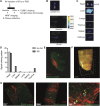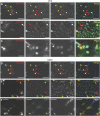Evaluation and manipulation of tissue and cellular distribution of cardiac progenitor cell-derived extracellular vesicles
- PMID: 36506565
- PMCID: PMC9729535
- DOI: 10.3389/fphar.2022.1052091
Evaluation and manipulation of tissue and cellular distribution of cardiac progenitor cell-derived extracellular vesicles
Abstract
Cardiac progenitor cell-derived extracellular vesicles (CPC-EVs) have been successfully applied via different delivery routes for treating post-myocardial infarction injury in several preclinical models. Hence, understanding the in vivo fate of CPC-EVs after systemic or local, i.e. myocardial, delivery is of utmost importance for the further therapeutic application of CPC-EVs in cardiac repair. Here, we studied the tissue- and cell distribution and retention of CPC-EVs after intramyocardial and intravenous injection in mice by employing different EV labeling and imaging techniques. In contrast to progenitor cells, CPC-EVs demonstrated no immediate flush-out from the heart upon intramyocardial injection and displayed limited distribution to other organs over time, as determined by near-infrared imaging in living animals. By employing CUBIC tissue clearing and light-sheet fluorescent microscopy, we observed CPC-EV migration in the interstitial space of the myocardium shortly after EV injection. Moreover, we demonstrated co-localization with cTnI and CD31-positive cells, suggesting their interaction with various cell types present in the heart. On the contrary, after intravenous injection, most EVs accumulated in the liver. To potentiate such a potential systemic cardiac delivery route, targeting the cardiac endothelium could provide openings for directed CPC-EV therapy. We therefore evaluated whether decorating EVs with targeting peptides (TPs) RGD-4C or CRPPR connected to Lamp2b could enhance EV delivery to endothelial cells. Expression of both TPs enhanced CPC-EV uptake under in vitro continuous flow, but did not affect uptake under static cell culture conditions. Together, these data demonstrate that the route of administration influences CPC-EV biodistribution pattern and suggest that specific TPs could be used to target CPC-EVs to the cardiac endothelium. These insights might lead to a better application of CPC-EV therapeutics in the heart.
Keywords: biodistribution; endothelial cell; exosome; extracellular vesicle; heart; targeting.
Copyright © 2022 Roefs, Heusermann, Brans, Snijders Blok, Lei, Vader and Sluijter.
Conflict of interest statement
The authors declare that the research was conducted in the absence of any commercial or financial relationships that could be construed as a potential conflict of interest.
Figures







Similar articles
-
Mononuclear phagocyte system blockade using extracellular vesicles modified with CD47 on membrane surface for myocardial infarction reperfusion injury treatment.Biomaterials. 2021 Aug;275:121000. doi: 10.1016/j.biomaterials.2021.121000. Epub 2021 Jun 28. Biomaterials. 2021. PMID: 34218049
-
Surface engineering enhances the therapeutic potential of systemically delivered extracellular vesicles following acute myocardial infarction.FASEB J. 2024 Sep 30;38(18):e70070. doi: 10.1096/fj.202400828R. FASEB J. 2024. PMID: 39301939
-
Extracellular vesicles from human cardiovascular progenitors trigger a reparative immune response in infarcted hearts.Cardiovasc Res. 2021 Jan 1;117(1):292-307. doi: 10.1093/cvr/cvaa028. Cardiovasc Res. 2021. PMID: 32049348
-
Extracellular vesicle-loaded hydrogels for tissue repair and regeneration.Mater Today Bio. 2022 Dec 21;18:100522. doi: 10.1016/j.mtbio.2022.100522. eCollection 2023 Feb. Mater Today Bio. 2022. PMID: 36593913 Free PMC article. Review.
-
Extracellular vesicles for ischemia/reperfusion injury-induced acute kidney injury: a systematic review and meta-analysis of data from animal models.Syst Rev. 2022 Sep 8;11(1):197. doi: 10.1186/s13643-022-02003-5. Syst Rev. 2022. PMID: 36076305 Free PMC article.
Cited by
-
Therapeutic potential of extracellular vesicles derived from cardiac progenitor cells in rodent models of chemotherapy-induced cardiomyopathy.Front Cardiovasc Med. 2023 Jul 7;10:1206279. doi: 10.3389/fcvm.2023.1206279. eCollection 2023. Front Cardiovasc Med. 2023. PMID: 37485274 Free PMC article.
-
Mesenchymal Stem Cell-Derived Exosomes: Emerging as a Promising Cell-Free Therapeutic Strategy for Autoimmune Hepatitis.Biomolecules. 2024 Oct 24;14(11):1353. doi: 10.3390/biom14111353. Biomolecules. 2024. PMID: 39595530 Free PMC article. Review.
-
A kaleidoscopic view of extracellular vesicles in lysosomal storage disorders.Extracell Vesicles Circ Nucl Acids. 2022 Dec 30;3(4):393-421. doi: 10.20517/evcna.2022.41. eCollection 2022. Extracell Vesicles Circ Nucl Acids. 2022. PMID: 39697359 Free PMC article. Review.
-
Targeted delivery of extracellular vesicles: the mechanisms, techniques and therapeutic applications.Mol Biomed. 2024 Nov 21;5(1):60. doi: 10.1186/s43556-024-00230-x. Mol Biomed. 2024. PMID: 39567444 Free PMC article. Review.
-
Extracellular vesicles in cardiovascular homeostasis and disease: potential role in diagnosis and therapy.Nat Rev Cardiol. 2025 Mar 5. doi: 10.1038/s41569-025-01141-2. Online ahead of print. Nat Rev Cardiol. 2025. PMID: 40045042 Review.
References
-
- Arslan F., Lai R. C., Smeets M. B., Akeroyd L., Choo A., Aguor E. N. E. E., et al. (2013). Mesenchymal stem cell-derived exosomes increase ATP levels, decrease oxidative stress and activate PI3K/Akt pathway to enhance myocardial viability and prevent adverse remodeling after myocardial ischemia/reperfusion injury. Stem Cell Res. 10, 301–312. 10.1016/j.scr.2013.01.002 - DOI - PubMed
Grants and funding
LinkOut - more resources
Full Text Sources
Research Materials

